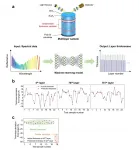Drug-delivery microcapsules tagged with zirconium-89 can be tracked by PET imaging
If these hollow capsules are modified to target a solid tumor, PET imaging and therapeutic ultrasound can be used to rupture them and release an anticancer drug at ground zero.
2021-01-21
(Press-News.org) BIRMINGHAM, Ala. - University of Alabama at Birmingham polymer and radionuclide chemists report what they say "may represent a major step forward in microcapsule drug delivery systems."
The UAB microcapsules -- labeled with radioactive zirconium-89 -- are the first example of hollow polymer capsules capable of long-term, multiday positron emission tomography, or PET, imaging in vivo. In previous work, UAB researchers showed that the hollow capsules could be filled with a potent dose of the cancer drug doxorubicin, which could then be released by therapeutic ultrasound that ruptures the microcapsules.
PET imaging with zirconium-89 -- which has a half-life of 3.3 days -- allowed the capsules to be traced in test mice up to seven days. The major step forward in the current research was covalent incorporation of a zirconium chelator, deferoxamine or DFO, into the layers of the microcapsules. This increased the tight binding of the positron emitter zirconium-89 onto the microcapsule wall.
"The produced systems represent an example of an advanced theranostic agent with the possibility to combine controlled drug delivery with stable PET imaging capabilities," said Eugenia Kharlampieva, Ph.D., and Suzanne Lapi, Ph.D., co-senior authors. "We believe this system also provides the groundwork for a universal drug delivery carrier that can be coupled with advanced targeted treatments, such as patient-tailored gene therapeutics, and can lead to the advancement of human health through molecularly targeted, image-guided precision drug delivery."
This drug delivery system -- after surface modifications to boost targeting capabilities -- could offer a non-invasive alternative to cancer surgery or systemic chemotherapy for solid tumors. The term theranostic, a portmanteau of the words therapy and diagnostic, refers to nanoparticles or microcapsules that can double as diagnostic imaging agents and as therapeutic drug-delivery carriers.
The relative paucity of zirconium-89 functionalized particles, Kharlampieva and Lapi suggest, may be due to both the scarcity of laboratories able to work with this isotope and the challenges associated with its stable incorporation into a polymeric drug carrier. At UAB, Kharlampieva is a professor in the UAB College of Arts and Sciences Department of Chemistry and a co-director of the UAB Center for Nanomaterials and Biointegration. Her polymer chemistry lab has pioneered research into hollow microcapsules that are built with alternating layers of biocompatible tannic acid and poly(N-vinylpyrrolidone), or TA/PVPON. The layers are formed around a sacrificial core that is dissolved after the layers are complete. In the current research, the chelator DFO was covalently linked to the PVPON, and the capsules were composed of alternating layers of TA and PVPON-DFO, for a total of six or 12 bilayers.
Lapi is professor of radiology and vice chair of Translational Research, and she is the director of the UAB Cyclotron Facility, which produces both clinical and investigational radionuclides. Lapi also directs the Radiochemistry Laboratory and the Division of Advanced Medical Imaging Research.
The UAB researchers found that (TA/PVPON-DFO) six-bilayer capsules retained, on average, 17 percent more zirconium-89 than their (TA/PVPON) counterparts, evidence that linking DFO to PVPON provides stable chelation. In vivo PET imaging of mice showed excellent stability and imaging contrast that was still present seven days post-injection. The capsules accumulated primarily in the spleen, liver and lungs, and there was negligible accumulation in the femur. Since the femur is the site where free zirconium-89 accumulates, this lack of accumulation in the femur confirmed stable binding of the radiotracer to the capsule. Finally, applying therapeutic levels of ultrasound to the zirconium-functionalized capsules released the anticancer drug doxorubicin -- loaded inside the microcapsules -- in therapeutic amounts.
Thus, the microcapsules overcome three limitations seen in the majority of current PET-guided theranostic agents: 1) poor retention of radiometal over time, 2) low drug-loading capacities, and 3) time-limited PET imaging capability.
INFORMATION:
Co-first authors of the study, "Multilayer microcapsules with shell-chelated 89Zr for PET imaging and controlled delivery," published in the journal ACS Applied Materials & Interfaces, were Veronika Kozlovskaya, Ph.D., and Aaron Alford, Ph.D., UAB Department of Chemistry.
Other co-authors with Kharlampieva, Lapi, Kozlovskaya and Alford are Maksim Dolmat and Racquel Caviedes, UAB Department of Chemistry; and Maxwell Ducharme and Lauren Radford, UAB Department of Radiology.
Support came from National Science Foundation Division of Materials Research award 1608728 and National Science Foundation Major Research Instrumentation Program award 1828232. Imaging studies were also supported through the O'Neal Comprehensive Cancer Center at UAB grant P30CA013148.
[Attachments] See images for this press release:

ELSE PRESS RELEASES FROM THIS DATE:
2021-01-21
NASA-funded research on the 11 largest freshwater lakes in the world coupled field and satellite observations to provide a new understanding of how large bodies of water fix carbon, as well as how a changing climate and lakes interact.
Scientists at the Michigan Tech Research Institute (MTRI) studied the five Laurentian Great Lakes bordering the U.S. and Canada; the three African Great Lakes, Tanganyika, Victoria and Malawi; Lake Baikal in Russia; and Great Bear and Great Slave lakes in Canada.
These 11 lakes hold more than 50% of the surface freshwater that millions of people and countless other creatures rely on, underscoring the importance of understanding how they are being altered by climate change and other factors.
The two Canadian lakes ...
2021-01-21
BUFFALO, N.Y. -- In the dark waters of Lake Superior, a fish species adapted to regain a genetic trait that may have helped its ancient ancestors see in the ocean, a study finds.
The research focuses on kiyis, which inhabit Lake Superior at depths of about 80 to over 200 meters deep. These fish, known to scientists as "Coregonus kiyi," belong to a group of closely related salmonids known as ciscoes.
In contrast to three other Lake Superior ciscoes that dwell and feed in shallower regions of water, the kiyis are far more likely to carry a version of the rhodopsin gene that probably improves vision in dim "blue-shifted" waters, ...
2021-01-21
Curtin University researchers have uncovered a method of making silicon, found commonly in electronics such as phones, cameras and computers, at room temperature.
The new technique works by replacing extreme heat with electrical currents to produce the same chemical reaction that turns silica into silicon at a reduced economic and environmental cost.
Lead researcher, PhD candidate Song Zhang from Curtin's School of Molecular and Life Sciences said that while the team's discovery was made at the nanoscale, it defines a way of replacing thermochemical processes with electrochemical processes, which ...
2021-01-21
With the recent explosive demand for data storage, ranging from data centers to various smart and connected devices, the need for higher-capacity and more compact memory devices is constantly increasing. As a result, semiconductor devices are now moving from 2D to 3D. The 3D-NAND flash memory is the most commercially successful 3D semiconductor device today, and its demand for supporting our data-driven world is now growing exponentially.
The scaling law for 3D devices is achieved by stacking more and more semiconductor layers, well above 100 layers, in a more reliable way. As each layer thickness corresponds to the effective channel length, accurate characterization and control of layer-by-layer thickness is critical. To date, ...
2021-01-21
Giant ambush-predator worms, possible ancestors of the 'bobbit worm', may have colonized the seafloor of the Eurasian continent around 20 million years ago. The findings, based on the reconstruction of large, L-shaped burrows from layers of seafloor dating back to the Miocene (23 million to 5.3 million years ago) of northeast Taiwan, are reported in Scientific Reports this week.
Ludvig Löwemark and colleagues reconstructed a new trace fossil, which they name Pennichnus formosae, using 319 specimens preserved within layers of seafloor formed during the Miocene era across northeast Taiwan. Trace fossils are geological features such as burrows, track marks and plant root cavities preserved ...
2021-01-21
BOSTON - Four years after patients with melanoma were treated with a personalized cancer vaccine, the immune response kindled by the vaccine remains robust and effective in keeping cancer cells under control, researchers at Dana-Farber Cancer Institute, Brigham and Women's Hospital, and the Broad Institute of MIT and Harvard report in a new study.
The findings, published online today by the journal Nature Medicine, demonstrate the staying power of the immune response generated by the vaccine, known as NeoVax, which works by targeting specific proteins on each patient's tumor cells. The researchers found that, nearly four ...
2021-01-21
While it has been reported that opioid overdose deaths have increased during the COVID-19 pandemic, a new study looking at data in Philadelphia showed that this hardship has been overwhelmingly suffered by Black individuals. Researchers from the Perelman School of Medicine at the University of Pennsylvania analyzed the period of time after the city's stay-at-home order was announced in 2020 and showed that, compared to the year before, the number of fatal overdoses suffered by Black individuals spiked by more than 50 percent. At the same time, the rate for white individuals actually fell by 31 percent over the same period. This research ...
2021-01-21
PORTLAND, OR - A first-of-its-kind randomized clinical trial found that patients with pancreatic cancer didn't live any longer than expected after receiving pre-operative chemotherapy from either of the two standard regimens, according to trial results published in JAMA Oncology.
While the trial findings did not show a direct patient benefit, they do show that it's possible to safely administer chemotherapy prior to pancreatic cancer surgery. They also pave the way for better treatment testing for this notorious killer. With no symptoms in the early stages, and few effective therapies, pancreatic cancer is the fourth-most deadly cancer type in the United ...
2021-01-21
What The Study Did: This study monitored suicide-related internet search rates during the early stages of the COVID-19 pandemic in the United States and researchers report searches for suicide decreased during that time. Although this study cannot independently confirm that changes in search rates were caused by changes in population-level suicide rates, it showed that COVID-19 may have been inversely associated with population suicide trends between March and July 2020.
Authors: John W. Ayers, Ph.D., M.A., of theUniversity of California San Diego, is the corresponding author.
To access the embargoed study: Visit our For The Media website at this link https://media.jamanetwork.com/
(doi:10.1001/jamanetworkopen.2020.34261)
Editor's ...
2021-01-21
What The Study Did: Evidence of SARS-CoV-2 RNA in human corneas was examined in this study.
Authors: Maria Casagrande, M.D., of the University Medical Center Hamburg-Eppendorf in Hamburg, Germany, is the corresponding author.
To access the embargoed study: Visit our For The Media website at this link https://media.jamanetwork.com/
(doi:10.1001/jamaophthalmol.2020.6339)
Editor's Note: The article includes conflict of interest and funding/support disclosures. Please see the article for additional information, including other authors, author contributions and affiliations, conflict of interest and financial disclosures, and funding and support.
INFORMATION:
Media advisory: The full article is linked to this news release.
Embed ...
LAST 30 PRESS RELEASES:
[Press-News.org] Drug-delivery microcapsules tagged with zirconium-89 can be tracked by PET imaging
If these hollow capsules are modified to target a solid tumor, PET imaging and therapeutic ultrasound can be used to rupture them and release an anticancer drug at ground zero.



